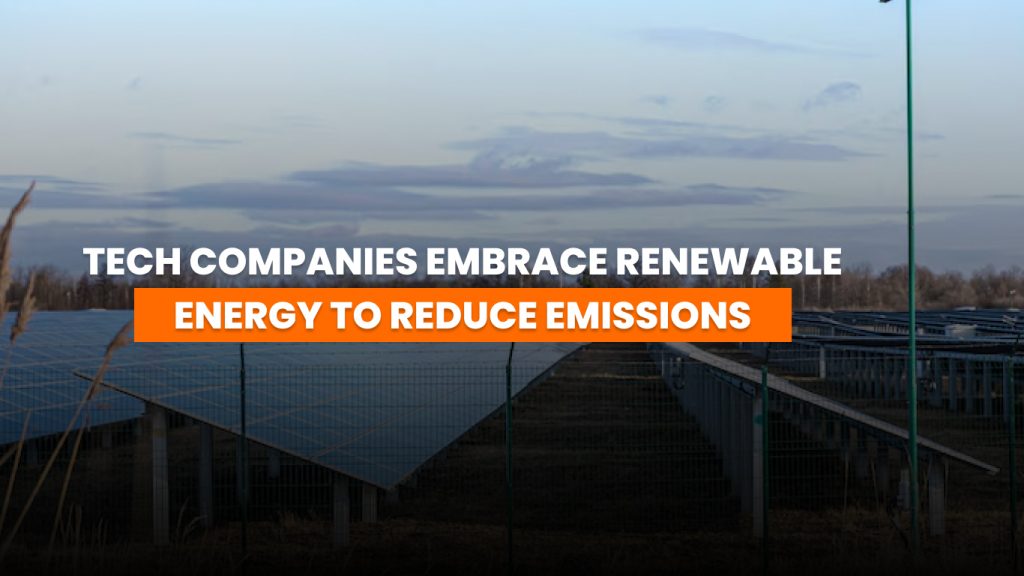Tech companies face unprecedented energy demand as digitalization, AI, and cloud computing drive data center expansion. The U.S. Energy Information Administration (EIA) has raised its forecast for commercial electricity sales accordingly. In fact, data center energy use is expected to rise by roughly 200 TWh per year by 2030. Such growth is straining power grids: in many regions, utilities are struggling to keep up. Some operators have even delayed retiring gas and coal plants to maintain reliability. These short-term fixes keep facilities online but increase carbon emissions and conflict with climate goals. In survey after survey, tech leaders emphasize that reliable, low-carbon power is critical: 84% of executives said they’d pay a premium to secure power quickly, and 82% select new sites based on grid capacity. In other words, securing clean, dependable electricity is now central to tech industry growth.
Corporate Emissions Goals
Nearly nine in ten tech companies report formal corporate emissions reduction targets. Over half already source at least 51% of their energy from zero-carbon sources. To reach these targets, firms are aggressively adding renewable power. Still, many rely on conventional sources during the transition: about 67% use standard utility contracts, roughly 50% maintain on-site gas or diesel backup generators, and nearly half purchase utility green tariffs offset by renewable energy credits. These measures help data centers run now but only partially reduce the carbon footprint.
Key clean energy initiatives include:
- Off-site renewable contracts (PPAs): ~40% of firms are signing deals with new wind or solar farms. These long-term power purchase agreements bring new green projects online and lock in fixed prices.
- On-site solar panels: ~38% plan to install photovoltaic arrays at their facilities, directly generating electricity on location.
- On-site battery storage: ~36% are adding batteries to store and dispatch renewable power, smoothing out intermittency.
These investments have clear payoffs. Most respondents said locking in new zero-carbon contracts is usually the most economical option, with combined on-site solar+storage as the next-best choice. In practice, companies like Amazon, Google, and Microsoft are funding large-scale renewable projects (often tens or hundreds of megawatts) through PPAs. Meanwhile, they maintain a foot in both worlds: many firms still rely partly on open-market power purchases and backup generation. This dual approach hedges risk – ensuring continuous supply now, while clean energy capacity scales up. Over time, as renewables grow, reliance on fossil backups will decline, enabling the sector to meet both growth and decarbonization goals.
Industry Leadership
Major tech firms are leading the clean energy transition. Amazon alone backs over 500 renewable energy projects that generate roughly 77,000 GWh of clean power each year. Microsoft, Google, Meta and others similarly procure gigawatts of wind and solar through long-term contracts. These corporate deals not only meet their own needs but also catalyze new clean projects on the grid. In parallel, companies complement PPAs with on-site solar and battery arrays: large office campuses and data centers often install rooftop panels and local battery banks. These on-site systems hedge against outages, lower peak grid demand, and further cut emissions. The result is an ecosystem effect – tech-driven renewable demand accelerates project development, while innovation in energy management makes those projects more valuable.
Efficiency and Innovation
Cutting energy waste is another core strategy. Almost 70% of tech firms now use advanced software and analytics to optimize usage, and many hire experts or install smart controls to eliminate inefficiencies. For example, AI-driven cooling and workload scheduling can shave data center peaks, reducing overall power draw. Energy management platforms (like NextEra’s 360 analytics) let operators mine operational data to find savings. Combined with more renewable energy and storage, these innovations allow data centers to do more computing per watt. In effect, each unit of computation has a smaller carbon footprint. Tech companies share best practices too; improvements at one facility often propagate across global networks. Together, these efforts mean that demand growth can proceed with much smaller increases in carbon emissions.
Collaboration and the Path Forward
Balancing growth with decarbonization is challenging. Grid operators frequently delay retiring fossil generators to maintain reliability, highlighting the tension between supply and sustainability. Tech companies meet this challenge through broad partnerships and diversified strategies. Over 80% of industry leaders report working with large-scale renewable providers across multiple locations. These collaborations – from bulk PPAs to joint project development and utility grid partnerships – allow firms to customize energy solutions. For example, some companies colocate data centers next to new wind or solar farms to share infrastructure and stabilize pricing. Others pursue novel sources: a few have signed PPAs for geothermal or even small modular nuclear power to bolster their clean energy supply.
In summary, by pairing renewable energy projects, storage, and efficiency innovations, tech companies are steadily aligning their expansion with sustainability goals. The industry’s progress shows that even amid surging demand, integrating solar panels, batteries, and smart energy use can keep tech growth in line with emission reduction targets.




